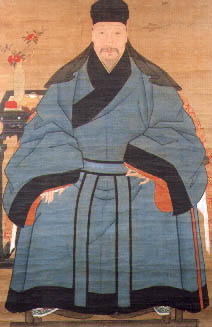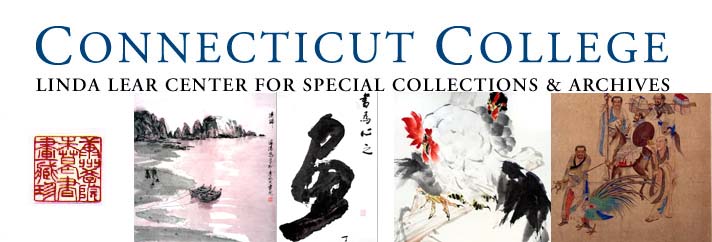Human Figure Paintings
Ancestral Portrait
Hanging Scroll, Chinese Ink on Rice Paper, 57 x 37 3/8 in., (145 x 95cm)
 Portrait painting in China has never been as popular as it is in the west. Philosophically, the Chinese do not consider human beings a superior subject for painting. Most of the extant examples of ancient portrait painting are of emperors and their consorts. Court artists were directed to paint likenesses of the emperors for ritual or didactic purposes. The common populace could not expect to have their ancestors or their own portraits painted for posterity.
Portrait painting in China has never been as popular as it is in the west. Philosophically, the Chinese do not consider human beings a superior subject for painting. Most of the extant examples of ancient portrait painting are of emperors and their consorts. Court artists were directed to paint likenesses of the emperors for ritual or didactic purposes. The common populace could not expect to have their ancestors or their own portraits painted for posterity.
Traditionally portraits were done elaborately with fine lines and bold colors. This style of painting is called "Detailed Painting" (kungpihua.) Each line, thick or thin, must be carefully drawn to achieve not only facial expression but also folds in robes to suggest bodily movement. The color of the robes indicates the status of the subject. Emperors are painted in yellow robes with dragon insignia. Officials wore red, deep blue or green to indicate rank. Portraits of Taoists and scholars are usually done in monochrome ink. Buddhist images are usually colorful.
This tradition began to change early in the sixteenth century when social and economic mobility created a new era for artistic expression. A demand for portrait painting developed as China entered the eighteenth and nineteenth centuries. Professional portrait painters grew in number to meet the needs of the times. Our painting is an example of an elderly gentleman painted in his traditional blue long gown. Modern scholars were often painted in western clothes.
Since 1949 portraits of political leaders or revolutionary models, portrayed in army or civilian clothes are widely seen in China. Since the eighties western influence has made portrait painting in oil on canvas currently popular.
This painting was donated by Dr. and Mrs. Monto Ho in 1991.
